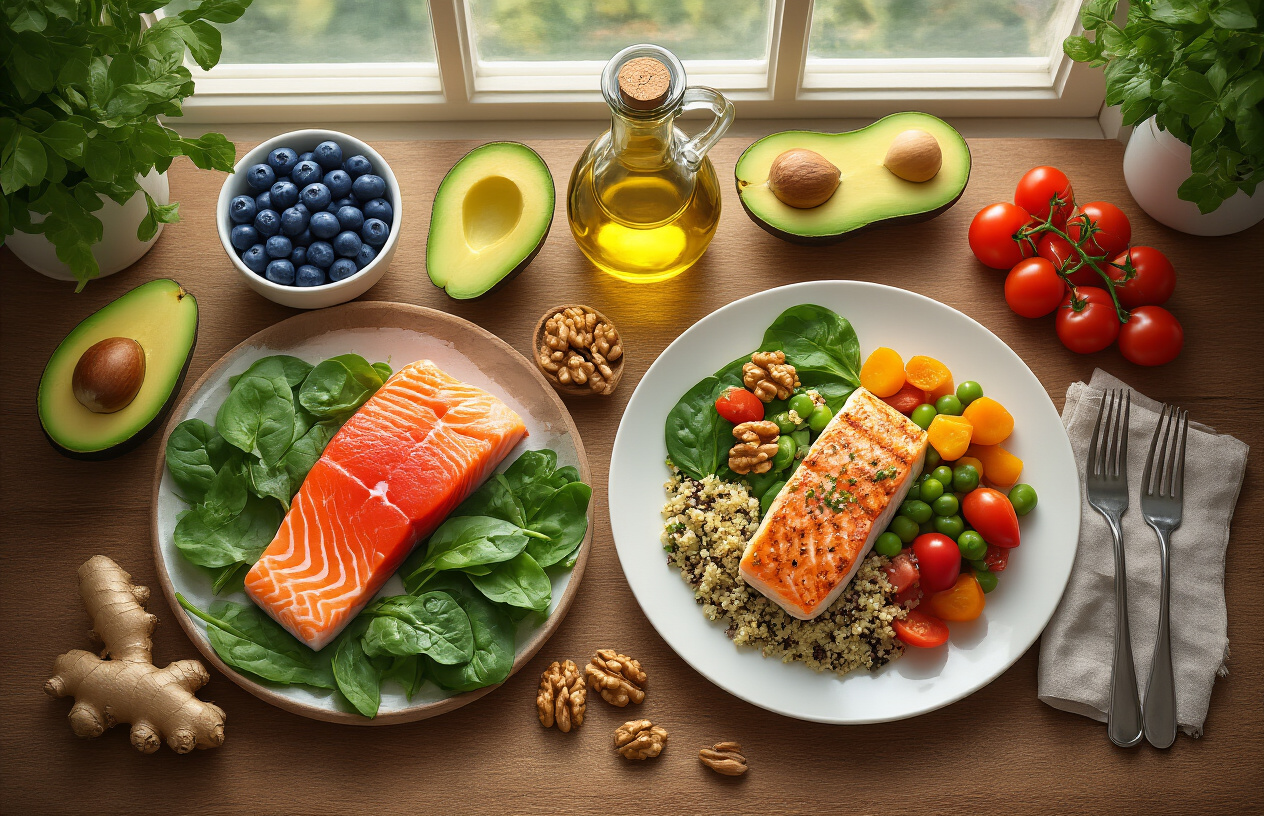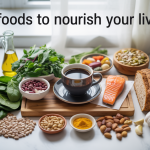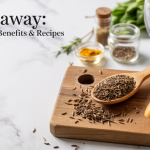How Diet Affects Inflammation: Your Complete Guide to Eating for Better Health
Chronic inflammation silently drives many health problems, from joint pain to heart disease. The good news? The foods you eat daily can either fuel inflammation or help your body fight it naturally.
This guide is for anyone dealing with inflammatory conditions, chronic pain, or simply wanting to prevent health issues before they start. You’ll also find practical advice if you’re caring for family members with inflammatory conditions.
We’ll explore which common foods trigger inflammatory responses in your body and discover powerful anti-inflammatory superfoods that can help reduce pain and boost healing. You’ll also learn how to create a personalized meal plan that fits your lifestyle and preferences.
Ready to transform your health one meal at a time? Let’s dive into how your food choices can become your most powerful medicine against inflammation.
Understanding Inflammation and Its Impact on Your Health

Recognize the difference between acute and chronic inflammation
Your body’s inflammatory response works like a skilled emergency crew. When you cut your finger or catch a cold, acute inflammation rushes to the scene. This short-term response brings increased blood flow, white blood cells, and healing compounds directly to the problem area. You’ll notice redness, swelling, heat, and sometimes pain – all signs that your immune system is doing its job. This type of inflammation typically lasts days to weeks and shuts down once the threat disappears.
Chronic inflammation operates completely differently. Instead of responding to a specific injury, it becomes a constant, low-grade fire burning throughout your body. This persistent state can last months or years, often without obvious symptoms. Your immune system stays activated even when there’s no clear threat to fight, creating a destructive cycle that damages healthy tissues.
The key difference lies in duration and purpose. Acute inflammation heals and protects, while chronic inflammation destroys and ages your body from the inside out.
Identify common symptoms of inflammatory conditions
Chronic inflammation often disguises itself as everyday complaints that many people dismiss as normal aging or stress. Persistent fatigue ranks among the most common signs – that bone-deep tiredness that doesn’t improve with rest. Joint pain and stiffness, especially in the morning, signal inflammatory processes affecting your musculoskeletal system.
Digestive issues frequently accompany chronic inflammation. You might experience bloating, gas, stomach pain, or irregular bowel movements. Skin problems like eczema, psoriasis, or persistent acne also reflect internal inflammatory processes.
Brain fog presents another telltale symptom. You may struggle with concentration, memory problems, or feel mentally sluggish. Mood changes, including increased anxiety or depression, often coincide with inflammatory states.
Other warning signs include:
- Frequent infections or slow wound healing
- Unexplained weight gain or difficulty losing weight
- Sleep disturbances or insomnia
- Headaches or migraines
- Allergies or asthma symptoms
- High blood pressure or elevated cholesterol
Learn how chronic inflammation damages your body over time
Chronic inflammation acts like acid slowly eating away at your body’s foundation. When inflammatory molecules circulate constantly through your bloodstream, they attack healthy cells and tissues indiscriminately. This cellular damage accumulates over years, setting the stage for serious health problems.
Your cardiovascular system bears significant damage from chronic inflammation. Inflammatory compounds damage artery walls, creating rough surfaces where cholesterol and other substances stick. This process leads to plaque buildup, increasing your risk of heart attacks and strokes. Blood vessels become less flexible, forcing your heart to work harder and raising blood pressure.
Your brain suffers as inflammatory molecules cross the blood-brain barrier. This neuroinflammation contributes to cognitive decline, memory problems, and increases the risk of neurodegenerative diseases like Alzheimer’s and Parkinson’s. The constant inflammatory assault disrupts normal brain function and accelerates mental aging.
Chronic inflammation also promotes insulin resistance, making it harder for your cells to use glucose effectively. This metabolic disruption increases your risk of type 2 diabetes and makes weight management more difficult. Inflammatory molecules interfere with hormones that regulate hunger and metabolism.
Your joints deteriorate as inflammatory compounds break down cartilage and damage surrounding tissues. This process leads to osteoarthritis and other degenerative joint conditions. Even your digestive system suffers, as chronic inflammation damages the intestinal lining and disrupts the balance of beneficial gut bacteria.
Foods That Trigger Inflammatory Responses

Avoid processed foods and refined sugars that spike inflammation
Your body treats refined sugars and processed foods like invaders, triggering an immediate inflammatory response. When you consume white bread, pastries, sugary drinks, or packaged snacks, your blood sugar skyrockets, causing your immune system to release inflammatory compounds called cytokines.
These ultra-processed foods contain artificial additives, preservatives, and high-fructose corn syrup that your digestive system struggles to recognize. Common culprits include:
- Packaged cookies and crackers
- Breakfast cereals with added sugars
- Soft drinks and energy drinks
- Frozen meals and instant soups
- White rice and refined flour products
The glycemic rollercoaster from these foods creates oxidative stress throughout your body, particularly affecting your joints, cardiovascular system, and digestive tract. Studies show people who regularly consume processed foods have elevated C-reactive protein levels—a key marker of chronic inflammation.
Eliminate trans fats and excessive omega-6 oils from your diet
Trans fats are inflammation’s best friend and your body’s worst enemy. These artificially created fats disrupt your cell membranes and trigger widespread inflammatory cascades. Even small amounts can increase inflammatory markers significantly.
While many foods no longer contain trans fats due to FDA regulations, check labels for “partially hydrogenated oils.” You’ll still find them in some margarine, shortening, and commercially baked goods.
Omega-6 oils present a more complex challenge. Your body needs some omega-6 fatty acids, but the typical Western diet provides 15-20 times more omega-6s than omega-3s. This imbalance fuels chronic inflammation.
High omega-6 oils to limit:
| Oil Type | Common Uses | Omega-6 Content |
|---|---|---|
| Soybean oil | Processed foods, restaurant cooking | Very high |
| Corn oil | Frying, baking | Very high |
| Sunflower oil | Cooking, salad dressings | High |
| Safflower oil | Cooking sprays, margarine | Very high |
Replace these with anti-inflammatory options like olive oil, avocado oil, or coconut oil for cooking.
Reduce consumption of red meat and processed meats
Red meat contains compounds that can trigger inflammatory responses, particularly when cooked at high temperatures. The iron in red meat, called heme iron, can promote the formation of inflammatory free radicals in your digestive system.
Processed meats pose an even greater threat. Bacon, sausages, hot dogs, and deli meats contain nitrates, excess sodium, and advanced glycation end products (AGEs) that directly activate inflammatory pathways. The World Health Organization has classified processed meats as carcinogenic, partly due to their inflammatory effects.
Inflammatory compounds in meat:
- AGEs from high-heat cooking methods
- Saturated fats that activate inflammatory genes
- Nitrates and nitrites in processed varieties
- Excess arachidonic acid promoting inflammatory prostaglandins
Consider limiting red meat to 2-3 servings per week and choose grass-fed options when possible. Completely avoid processed meats or reserve them for occasional treats rather than daily consumption.
Limit alcohol intake to prevent inflammatory flare-ups
Alcohol creates a perfect storm for inflammation in your body. Your liver produces inflammatory byproducts when breaking down alcohol, while simultaneously depleting crucial antioxidants that normally keep inflammation in check.
Regular drinking damages your gut lining, allowing inflammatory toxins to leak into your bloodstream—a condition called “leaky gut syndrome.” This triggers your immune system to remain constantly activated, creating chronic low-grade inflammation throughout your body.
Even moderate alcohol consumption can worsen existing inflammatory conditions like arthritis, inflammatory bowel disease, or autoimmune disorders. The inflammatory effects are dose-dependent, meaning more alcohol equals more inflammation.
Safe alcohol guidelines for inflammation management:
- Women: Maximum 1 drink per day
- Men: Maximum 2 drinks per day
- Include alcohol-free days each week
- Choose red wine occasionally for its antioxidants
- Avoid sugary cocktails and beer with high carbohydrate content
Pay attention to how your body responds after drinking. Joint pain, digestive issues, or skin flare-ups the next day often indicate alcohol is triggering inflammation in your system.
Anti-Inflammatory Superfoods That Heal Your Body

Incorporate omega-3 rich fish and seafood into weekly meals
Fatty fish stands as nature’s most powerful anti-inflammatory weapon. Salmon, mackerel, sardines, and anchovies deliver EPA and DHA omega-3 fatty acids that actively reduce inflammatory markers in your bloodstream. These essential fats work by blocking inflammatory pathways and promoting the production of specialized pro-resolving mediators that help your body heal damaged tissues.
Wild-caught salmon provides the highest concentration of omega-3s, with a 3.5-ounce serving containing nearly 2 grams of these healing fats. Canned sardines offer an affordable alternative while delivering similar benefits. For maximum anti-inflammatory impact, include fatty fish in your diet 2-3 times per week.
Fresh seafood options like oysters, mussels, and cold-water shrimp also contain meaningful amounts of omega-3s alongside zinc and selenium, minerals that support your immune system’s anti-inflammatory responses.
Add colorful fruits and vegetables packed with antioxidants
The vibrant colors in fruits and vegetables signal the presence of powerful antioxidant compounds that neutralize inflammation-causing free radicals. Dark leafy greens like spinach, kale, and Swiss chard contain high levels of vitamins A, C, and K, along with folate and iron that support cellular repair processes.
Berries pack exceptional anti-inflammatory punch. Blueberries, blackberries, and cherries contain anthocyanins that reduce inflammatory markers as effectively as some medications. These compounds cross the blood-brain barrier, protecting neural tissue from inflammatory damage.
Colorful vegetables deliver specific anti-inflammatory benefits:
- Purple vegetables (eggplant, red cabbage) contain betalains that reduce inflammatory enzymes
- Orange vegetables (carrots, sweet potatoes) provide beta-carotene that modulates immune responses
- Red vegetables (tomatoes, red peppers) offer lycopene, a potent inflammation fighter
- Green vegetables (broccoli, Brussels sprouts) supply sulforaphane that activates detoxification pathways
Include nuts, seeds, and healthy fats for natural inflammation control
Raw nuts and seeds function as concentrated sources of anti-inflammatory nutrients. Walnuts contain the highest levels of plant-based omega-3 fatty acids among tree nuts, while almonds provide vitamin E that protects cell membranes from inflammatory damage.
Flaxseeds and chia seeds offer alpha-linolenic acid (ALA), which your body converts to active omega-3s. Ground flaxseed works better than whole seeds since your digestive system can access the nutrients more easily. Hemp hearts provide a complete protein profile alongside anti-inflammatory gamma-linolenic acid.
Healthy fats from avocados, olive oil, and coconut oil support the absorption of fat-soluble vitamins while providing their own anti-inflammatory benefits. Extra virgin olive oil contains oleocanthal, a compound with similar anti-inflammatory effects to ibuprofen. Use cold-pressed oils and consume nuts and seeds in their raw state to preserve these delicate beneficial compounds.
Use powerful spices like turmeric and ginger for daily healing
Turmeric contains curcumin, perhaps the most researched anti-inflammatory compound in the culinary world. This bright yellow spice blocks multiple inflammatory pathways simultaneously and stimulates the production of your body’s natural antioxidant enzymes. Combine turmeric with black pepper to increase curcumin absorption by up to 2000%.
Fresh ginger contains gingerols and shogaols that inhibit inflammatory prostaglandins and leukotrienes. Regular ginger consumption reduces inflammatory markers in people with arthritis and other inflammatory conditions. Add fresh grated ginger to smoothies, teas, and stir-fries for maximum potency.
Other inflammation-fighting spices include:
| Spice | Active Compound | Anti-Inflammatory Action |
|---|---|---|
| Cinnamon | Cinnamaldehyde | Reduces inflammatory cytokines |
| Cloves | Eugenol | Inhibits inflammatory enzymes |
| Garlic | Allicin | Blocks inflammatory pathways |
| Rosemary | Carnosic acid | Protects against oxidative stress |
Choose whole grains over refined carbohydrates for sustained energy
Whole grains maintain their fiber, vitamins, and minerals, creating a steady blood sugar response that prevents inflammatory spikes. Refined carbohydrates trigger rapid glucose increases that activate inflammatory pathways and promote the release of inflammatory cytokines.
Quinoa provides complete protein alongside fiber and magnesium, both essential for controlling inflammation. Steel-cut oats contain beta-glucan, a soluble fiber that reduces inflammatory markers and supports beneficial gut bacteria. Brown rice, wild rice, and ancient grains like farro and bulgur offer sustained energy without the inflammatory burden of processed alternatives.
The fiber in whole grains feeds beneficial gut bacteria that produce short-chain fatty acids, compounds that directly reduce systemic inflammation. This gut-health connection makes whole grain consumption particularly important for managing chronic inflammatory conditions.
Creating Your Personal Anti-Inflammatory Meal Plan

Design balanced meals that fight inflammation naturally
Building meals that naturally combat inflammation starts with filling half your plate with colorful vegetables and fruits. Think deep leafy greens, vibrant berries, and bright orange sweet potatoes – these foods pack the most anti-inflammatory punch. The remaining half should split between lean proteins like wild salmon, grass-fed beef, or plant-based options like lentils, and healthy fats such as avocados, nuts, and olive oil.
Each meal needs a foundation of fiber-rich foods that feed beneficial gut bacteria. When your gut microbiome thrives, it produces compounds that actively reduce inflammation throughout your body. Quinoa, brown rice, and steel-cut oats make excellent bases, while adding fermented foods like sauerkraut or kimchi provides probiotics that support this process.
Spices and herbs deserve a starring role in every anti-inflammatory meal. Turmeric, ginger, garlic, and rosemary don’t just add flavor – they deliver potent anti-inflammatory compounds. A simple rule: if your meal looks colorful and smells aromatic, you’re probably on the right track.
Time your eating patterns to optimize inflammatory response
Your body’s inflammatory response follows a natural rhythm that changes throughout the day. Eating your largest, most nutrient-dense meal earlier helps align with your body’s peak metabolic hours when it can best process anti-inflammatory compounds.
Intermittent fasting windows of 12-16 hours give your digestive system time to reset and reduce inflammatory markers. Many people find success eating their last meal by 7 PM and breaking their fast around 9-11 AM the next day. This approach allows cellular repair processes to work more effectively.
Late-night eating disrupts these natural cycles and can trigger inflammatory responses. Your body expects to fast during sleep, so eating close to bedtime forces it to divert energy from repair work to digestion, potentially increasing inflammatory markers.
Combine foods strategically for maximum anti-inflammatory benefits
Certain food combinations create synergistic effects that amplify their individual anti-inflammatory properties. Pairing turmeric with black pepper increases curcumin absorption by up to 2000%. Adding a drizzle of olive oil to tomato-based dishes helps your body absorb more lycopene, a powerful anti-inflammatory compound.
Fat-soluble vitamins A, D, E, and K need healthy fats for proper absorption. Eating carrots with almonds or spinach with olive oil maximizes the anti-inflammatory benefits of these nutrients. Similarly, combining vitamin C-rich foods like bell peppers with iron-rich leafy greens enhances iron absorption while providing complementary antioxidants.
Creating meals with both soluble and insoluble fiber feeds different types of beneficial bacteria in your gut. Mix beans or oats (soluble fiber) with vegetables like broccoli or Brussels sprouts (insoluble fiber) to create a diverse gut environment that produces more anti-inflammatory compounds.
Lifestyle Factors That Amplify Diet’s Anti-Inflammatory Effects

Manage stress levels to prevent diet sabotage
Chronic stress wreaks havoc on your body’s inflammatory response, essentially undoing the benefits of your carefully chosen anti-inflammatory foods. When you’re stressed, your body pumps out cortisol, a hormone that triggers inflammation throughout your system. This means even if you’re eating all the right foods, stress can completely derail your efforts.
Your gut takes a particularly hard hit when stress levels spike. The connection between your brain and digestive system means that anxiety and tension can disrupt healthy gut bacteria, increase intestinal permeability, and trigger inflammatory responses that spread throughout your body.
Simple stress management techniques can make a dramatic difference in how your body responds to anti-inflammatory foods:
- Deep breathing exercises: Just five minutes of focused breathing can lower cortisol levels
- Meditation or mindfulness: Even short sessions help reset your nervous system
- Regular massage or self-massage: Physical touch reduces stress hormones naturally
- Time in nature: Walking outdoors decreases inflammation markers more effectively than indoor exercise
- Limiting news and social media: Constant exposure to negative information keeps stress hormones elevated
Prioritize quality sleep for optimal inflammatory recovery
Sleep isn’t just about feeling rested – it’s when your body repairs inflammatory damage and resets its immune system. Poor sleep quality can increase inflammatory markers by up to 70%, making your anti-inflammatory diet work much harder to achieve results.
During deep sleep phases, your body produces growth hormone and other repair compounds that actively reduce inflammation. When you consistently get less than seven hours of quality sleep, your body struggles to process the beneficial compounds from anti-inflammatory foods effectively.
Sleep deprivation also affects your food choices the next day. Tired brains crave quick energy from processed foods and sugar, which can trigger inflammatory responses that counteract your healthy eating efforts. Creating a sleep-supportive environment enhances your diet’s anti-inflammatory power:
| Sleep Factor | Impact on Inflammation | Quick Fix |
|---|---|---|
| Room temperature | Cool rooms (65-68°F) support deeper sleep | Adjust thermostat or use fans |
| Light exposure | Blue light blocks melatonin production | Use blue light filters after sunset |
| Eating timing | Late meals disrupt sleep quality | Stop eating 3 hours before bed |
| Caffeine intake | Stays in system 6-8 hours | No caffeine after 2 PM |
Incorporate regular exercise to boost anti-inflammatory benefits
Exercise acts like a multiplier for your anti-inflammatory diet, amplifying the benefits of healthy foods while creating its own powerful anti-inflammatory effects. Regular physical activity stimulates the production of anti-inflammatory compounds called myokines, which work alongside the antioxidants from your food to fight inflammation more effectively.
The type and timing of exercise matters for maximizing anti-inflammatory benefits. Moderate exercise consistently outperforms intense workouts when it comes to reducing chronic inflammation. High-intensity exercise can actually increase inflammatory markers temporarily, though this isn’t necessarily harmful if balanced with proper recovery.
Best anti-inflammatory exercise combinations:
- Walking after meals: Improves nutrient absorption and reduces post-meal inflammation
- Strength training 2-3 times weekly: Builds muscle that produces anti-inflammatory compounds
- Yoga or tai chi: Combines movement with stress reduction for double benefits
- Swimming: Low-impact cardio that doesn’t stress joints or trigger excessive inflammation
- Stretching daily: Improves circulation and helps deliver anti-inflammatory nutrients throughout your body
Timing your exercise around meals can enhance how your body uses anti-inflammatory foods. Light activity after eating helps your body better absorb nutrients like omega-3 fatty acids and antioxidants.
Stay hydrated to support your body’s natural healing processes
Water plays a crucial role in how effectively your body can use anti-inflammatory nutrients from food. Dehydration thickens your blood, making it harder for beneficial compounds to reach inflamed tissues. It also concentrates inflammatory waste products in your system, working against your dietary efforts.
Proper hydration supports every aspect of your anti-inflammatory diet plan. Your digestive system needs adequate water to break down foods and absorb nutrients efficiently. Your liver requires plenty of fluids to process and eliminate inflammatory toxins. Even your joints depend on proper hydration to maintain the synovial fluid that prevents inflammatory wear and tear.
The quality of your water matters as much as the quantity. Chlorinated tap water can disrupt beneficial gut bacteria, while plastic bottles may introduce hormone-disrupting chemicals that trigger inflammation.
Hydration strategies that enhance anti-inflammatory eating:
- Drink a large glass of water upon waking to support morning detox processes
- Add lemon or cucumber to water for extra anti-inflammatory compounds
- Sip water throughout the day rather than drinking large amounts at once
- Choose herbal teas like green tea or turmeric tea for added anti-inflammatory benefits
- Monitor urine color – pale yellow indicates optimal hydration for nutrient transport

Your food choices play a huge role in whether your body stays in a state of chronic inflammation or finds its way back to balance. The processed foods, excess sugar, and refined oils that fill many of our plates can keep inflammation levels high, while nutrient-dense whole foods like leafy greens, fatty fish, and colorful berries work like natural medicine to cool things down. Building an anti-inflammatory meal plan doesn’t have to be complicated – it’s about crowding out the troublemakers with foods that actually nourish your body.
The real magic happens when you combine smart eating with other inflammation-fighting habits like getting quality sleep, managing stress, and staying active. These lifestyle factors work together to amplify the healing power of your diet, creating a powerful one-two punch against chronic inflammation. Start small by swapping out one inflammatory food this week and adding one anti-inflammatory option to your daily routine. Your body will thank you for every positive change you make, and you might be surprised at how much better you feel when inflammation isn’t constantly working against you.














